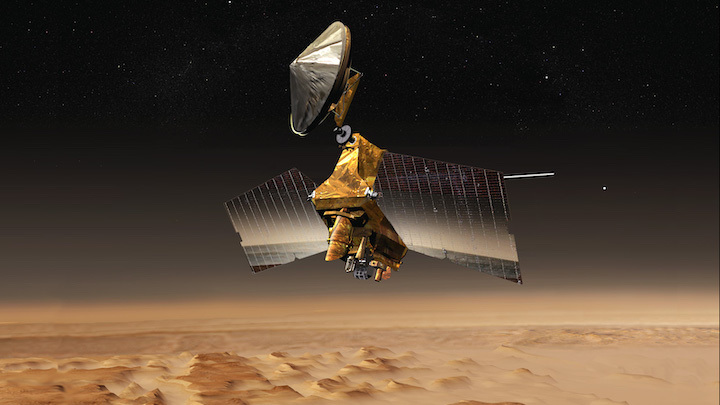19.02.2020

This artist's concept shows NASA's Mars Reconnaissance Orbiter over the red planet.Credit: NASA/JPL-Caltech
Other orbiters will continue relaying data from Mars surface missions for a two-week period.
From Feb. 17 to Feb. 29, 2020, NASA's Mars Reconnaissance Orbiter (MRO) will go on hiatus from its science mission and its relay operations while engineers on Earth conduct long-distance maintenance. During the hiatus, other orbiters will relay data from the Mars Curiosity rover and Mars InSight lander to Earth.
The maintenance work involves updating battery parameters in the spacecraft's flash memory - a rare step that's been done only twice before in the orbiter's 15 years of flight. This special update is necessary because it was recently determined that the battery parameters in flash were out of date and if used, would not charge MRO's batteries to the desired levels.
In addition to the battery parameters, engineers will use this opportunity to update planetary position tables that also reside in flash. The spacecraft will go into a precautionary standby mode, called safe mode, three times over the course of the update. It will also swap from its primary computer, called its Side-A computer, to its redundant one, called Side-B.
Mars Reconnaisance Orbiter launched in 2005 and arrived at the Red Planet on March 10, 2006. Since then, the spacecraft has returned 371 terabits of data. Long-lived spacecraft need to guard against failures of aging hardware and the effects of the harsh space environment, such as damage from cosmic rays.
Whenever a spacecraft detects a technical issue, there's a series of actions it can take, including swapping to a redundant side of its electronics or rebooting its computer. Success in those cases depends upon restoring an uncorrupted, up-to-date version of an operating system with its parameter files from flash memory. To guard against corruption of the flash memory itself, multiple copies of essential parameters are stored onboard.
To keep both of the redundant computers up to date, engineers will update the flash on the Side-A computer first and then command a Side-A reboot to ensure that the flash memory was properly updated. Once they confirm the changes have taken effect, they'll swap to Side-B and repeat the process.
After validation of the memory updates, MRO will return to its science and relay-support activities. With this update, the mission will be poised to continue operations well into the next decade.
Quelle: NASA
